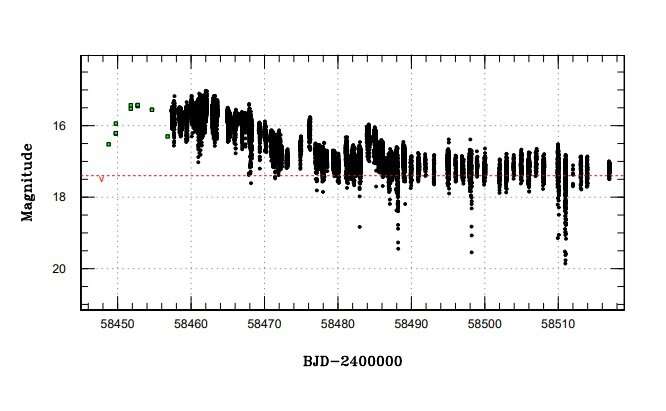Light curve of ASASSN-18aan. Credit: Wakamatsu et al., 2021.
An international team of astronomers has performed photometric and spectroscopic observations of a binary star system known as ASASSN-18aan and have found that the object is an unusual cataclysmic variable with a relatively long orbital period. The findings were presented February 9 on the arXiv pre-print server.
Cataclysmic variables (CVs) are binary star systems consisting of a white dwarf primary that is accreting matter from a normal star companion. They irregularly increase in brightness by a large factor, then drop back down to a quiescent state. These binaries have been found in many environments, such as the center of the Milky Way galaxy, the solar neighborhood, and within open and globular clusters.
Some CVs, which experience recurrent outbursts of 2-10 magnitude caused by accretion disk instabilities, are called dwarf novae (DNe). One subclass of these novae, known as SU UMa-type DNe, showcases long-lasting, brighter outbursts (superoutbursts) in addition to normal bursting activity.
According to a new study conducted by astronomers led by Yasuyuki Wakamatsu of the Kyoto University, Japan, ASASSN-18aan turns out to be one of SU UMa-type DNe with peculiar properties. ASASSN-18aan was detected on November 30, 2018, during its outburst, by the All-Sky Automated Survey for Supernovae (ASAS-SN). After the discovery, a photometric and spectroscopic observational campaign of this source started using various telescopes.
"We report photometry and spectroscopy of the eclipsing SU UMa-type DN ASASSN-18aan in its 2018 outburst and following quiescence," the astronomers wrote in the paper.
The observations show that the super-outburst of ASASSN-18aan experienced a slow growth rate of super-humps and rebrightenings. The orbital period of the system was derived to be approximately 0.149 days (about 3.6 hours), which is extremely long for a typical SU UMa-type DN. Most objects of this type have orbital periods shorter than two hours.
The secondary star in the system, of spectral type G9, is also unusual. The object is much hotter (above 5,000 K) than typical CV secondaries with similar orbital periods, and is much less massive (about 0.18 solar masses) than its surface temperature would suggest. Therefore, ASASSN-18aan is a new addition to a small group of CVs known to have anomalously warm secondary stars. The mass of the primary star was found to be around 0.6 solar masses.
Summing up the study, the researchers noted that the unusual properties of ASASSN-18aan are most likely a result of mass transfer that began after the secondary star had undergone significant nuclear evolution. They added that what we see today as ASASSN-18aan is the stripped core of a much larger star.
"Anomalously hot secondaries are seen in a modest number of other CVs and related objects. These systems evidently underwent significant nuclear evolution before the onset of mass transfer," the astronomers explain.
More information: ASASSN-18aan: An Eclipsing SU UMa-type Cataclysmic Variable with a 3.6-hour Orbital Period and a Late G-type Secondary Star, arXiv:2102.04104 [astro-ph.SR] arxiv.org/abs/2102.04104
© 2021 Science X Network
























